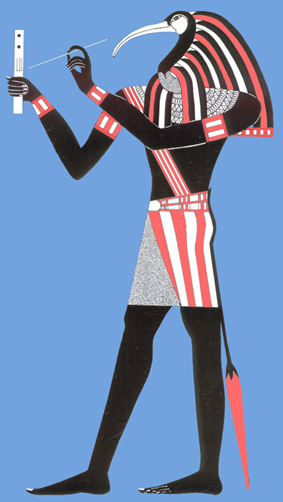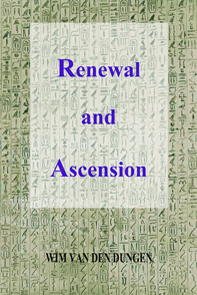|
THOTH

by Wim van den Dungen
The meaning of
Thoth's name ("DHwtii" or "Djehuti"), represented by the hieroglyph of the
Ibis, is unknown. Egyptologists propose "he of Djehout" (an
unknown location), "he of the castle of speech",
"he who speaks in the temple", "messenger",
"he who selects", "he who chooses".
Hopfner
(1914) thinks that "DHw" could have been the
oldest name of the Ibis, implying that Thoth would mean
: "he who has the nature of the Ibis". Nothing is certain. He
seems an accumulation of cognitive deities.
This bird appeared perched on a standard on
slate palettes of the Terminal Predynastic Period. The sacred Ibis had a long
curved beak, suggestive of the crescent New Moon, and black & white
feathering reminiscent of the Lunar phases of waxing & waning.
In the
Old Kingdom, the association between the Ibis and Thoth had already been
made, for in the afterlife, the wings of Thoth carried Pharaoh over the
celestial river.
|

THOTH
god of scribes, science, magic, time medicine, reckoning, cults,
wisdom and the peace of the gods
companion of MAAT
drawing by
Stéphane Rossini |
|
Another, less common, pictogram for Thoth was the squatting baboon, who greeted the
dawning Sun with agitated, chattering sounds. These baboons are also represented on
their hind legs with front paws raised in praise and greeting of Re, facing the rising Sun.
Thoth often wears a crown representing the crescent Moon
supporting the disk of the Full Moon. In the Middle Kingdom, he was worshipped in all of Egypt. In all major
temples, the cults of both Thoth (and that of his spouse Maat) were present. |
The god's
birth was, according to one legend, unnatural (he sprang from Seth's
head). Thoth was the secretary of Re, the "scribe of the gods" and also Re's messenger who
promulgated Atum-Re's laws. He was the great conciliator among the deities,
because the "peace of the gods" is in him. He was a traveller and an international deity, for his name can
be found in many ancient languages : neo-Babylonian, Coptic,
Aramean, Greek & Latin.
Thoth represented the embodiment of all knowledge and
literature. He had invented writing and wrote himself. He was at the comand of all the divine books in the House of
Life attached to all major temples of Egypt. The wisdom of Thoth was revered and considered too secret for profane eyes.
In the story of the magician Djedi, a man of a hundred and ten, we read that he knew the number of the secret chambers of the sanctuary of
Thoth, the "word of the god Re". He is called the
"son of Re" and "Lord of the eight gods" (the Ogdoad of
Hermopolis). In the funerary rituals, Thoth acted the part of the recorder,
and his decision was accepted by all deities. Thoth observed whether the
heart (mind) of the deceased was light enough to balance the feather of truth
& justice. This by "weighing the words", for the heaviness of
heart was the result of unwholesome speech (cf. the insistence on silence
also served magical purposes). Thoth was also the ultimate teacher of magic,
ritualism & the words of power which opened the secret pylons of the underworld.
His original home was Khemenu, or "eight-town", referring to
the four pairs of mythical chaos-gods existing before creation, of which Thoth became the
leader and head. The Greeks called it Hermopolis ("city of Hermes").
In Hermopolitan theology, the Nun was personified by the Ogdoad,
showing that this theology was intimately linked with the "mind of Re"
speaking its Great Word (the sacred Ibis dropping the Great Word in the
limitless ocean of inert possibilities), which transformed the pre-creational, chaotic Ogdoad (cf.
the four female snake-goddesses & four male
frog-gods with Predynastic roots) into the Ennead of Hermopolis headed
by the "first of the eight", the Great Word of Re. The Hermopolitan
scheme is cognitive, conceptual and promotes the Eastern idea that speech has
creative & magical power.
As in Memphite theology of Ptah, the original great god (here Thoth)
creates it all with divine words in his mind and on his tongue, a
prefiguration
of the Greek logos-philosophy. The Heliopolitan scheme added the
self-generative aspect of the deity (the great "he/she" being
"causa sui"), as well as the eternal participation (from the
first moment) between the One and his children (Shu and Tefnut), i.e. the
triadic conceptualization of the godhead, a trinity of divine persons
(expanding into "millions"), the principle of intra-divine
participationism. HERMES
TRISMEGISTUS When
the Greeks had to acclimatize to Egypt, they took the initiative in
identifying their gods with native divinities. Thoth was probably the most
popular and diverse deity of the Egyptian pantheon. Indeed, in the Late
New Kingdom, Third Intermediate and Late
Period, individual destiny and fate had become increasingly important.
Both lay in the hand of
the gods.
Although a national deity, Thoth had local associations and
particularities and was regarded as a Moon-god, determining the rhythms of
Egyptian national life (festivals & calendars). As "Lord of
Time", Thoth, the mysterious, ruled individual destinies too, and
was thus very popular. By extension he was lord of knowledge, language, all
science, magic, writing and understanding. He was the creator who called
things into being merely by the sound of his voice. As guide and judge of the
dead, Thoth owed much popularity with common people, and the "power of the
Moon" was invoked in the wisdom
teachings.
The Greek settlers identified their god Hermes with Thoth. Like Thoth, he
was Lunar, and associated with medicine and the realm of the dead. Both
were tricksters and messengers. Hermes was the "logos", the
interpreter of Divine Will to humanity. In Stoic philosophy, Hermes is
both "logos" and "demiurge", which probably owed
something to the Hermopolitans. In Alexandrian Egypt, the Greek Hermes (identified
with Thoth), became cosmopolitan and Hellenistic, but Egyptianized and
known throughout the Roman world as "the Egyptian".
Interestingly, by intermingling native Egyptian (Thoth) and Greek theology
(Hermes) with Hellenistic philosophy, a syncretic sum was produced, a
major and crucial archetypal idea, which encompassed the function of the
cognitive in the Mediterranean cultures of before Christianity :
Hermes
Trismegistus, or Hermes the "Thrice Greatest", for during their
rituals, the Egyptians used to call Thoth "Great ! Great ! Great
!".
However, by people of Greek culture, Trismegistus was not invisaged in the
same way as the Egyptians saw him. The Greeks produced fictional stories to
explain the emergence of Hermes Trismegistus (cf. the
Tabula
Smaragdina). For
example, it was widely circulated that Homer was an Egyptian and a son of
Hermes ! The learned Greeks invented a "human" Trismegistus.
The
"philosophical" Hermetica (the Corpus Hermeticum)
presented Hermes as a teacher of wisdom. However, in the
"technical" Hermetica (the Greek magical papyri which readapt
Egyptian magic), Thoth appeared, for there Trismegistus was seen as a
cosmic deity, able to dwell in the heart of his devotees and object of
identification for the magician. This ambiguity of Hermes Trismegistus,
the dual-union between the Divine and the human, must have struck many. It
may explain why Hermes is mentioned in early Christian literature (cf.
the two natures of Christ). Hermetical principles were imported in
Europe in the XI - XIIth century by the monastic movement (as part of the
"Orientale Lumen" - cf. Bernard of Clairvaux, Willem of
St.Thierry).
"In particular
there is little Christian polemical literature directed against the
Hermetists, for pagans were in general less of a threat to the Church than
heretics, and Trismegistus in particular had anyway been a prophet of
Christ. For that reason -and others- he was often quoted, even
approvingly, by the Fathers ..."
Fowden,
1993, p.195.
Hermes Trismegistus the wisdom-teacher influenced both Christianity and
Islam. Besides its dogmatic canon,
Early Christianity was influenced by
neo-Platonism and Stoicism, both linked with
Alexandrian Hermetism, and
the pagan notions of "Divine Mind", "World Soul",
"Demiurge" and "Pure Act" (developed in the New Kingdom
and returning in Classical Greek philosophy). Through Harran, Hermes
established his place in Islamic sciences, which in turn would help
initiate the European Renaissance in XIIIth century Italy. It is at this
point that a new mixture was brewed, one which called into being a
re-Platonized egyptomanic Hermeticism that would conquer Europe and
finally the New World. It is still with us in Egyptian Masonic Orders and
the various branches of Californian
New Age religion.
Three fundamental phases appear :
-
native
Hermopolitan theology : the perennial worship of the native
Egyptian Thoth, "Thrice Greatest", centered in Hermopolis
("Hermoupolis Magna") ;
-
historical
Hermetism : the identification of Thoth with Hermes Trismegistus,
who, in his Graeco-Alexandrian, philosophical teachings (between
ca.150 BCE and 250 CE) is
Greek and human (although Egyptian elements persist), but
who assumed, in the technical Hermetica, the cosmicity of the Egyptian
Thoth ;
-
literary
Hermeticism : the Renaissance produced a fictional European
Trismegistus, based on
the
Alexandrian Hermes and a misunderstood
Ancient Egyptian. Trismegistus became the patron of alchemy, magic,
mystery orders, freemasonry, astrology, the New Age, the Western
tradition ... and all matters occult.
|

![]()
![]()
